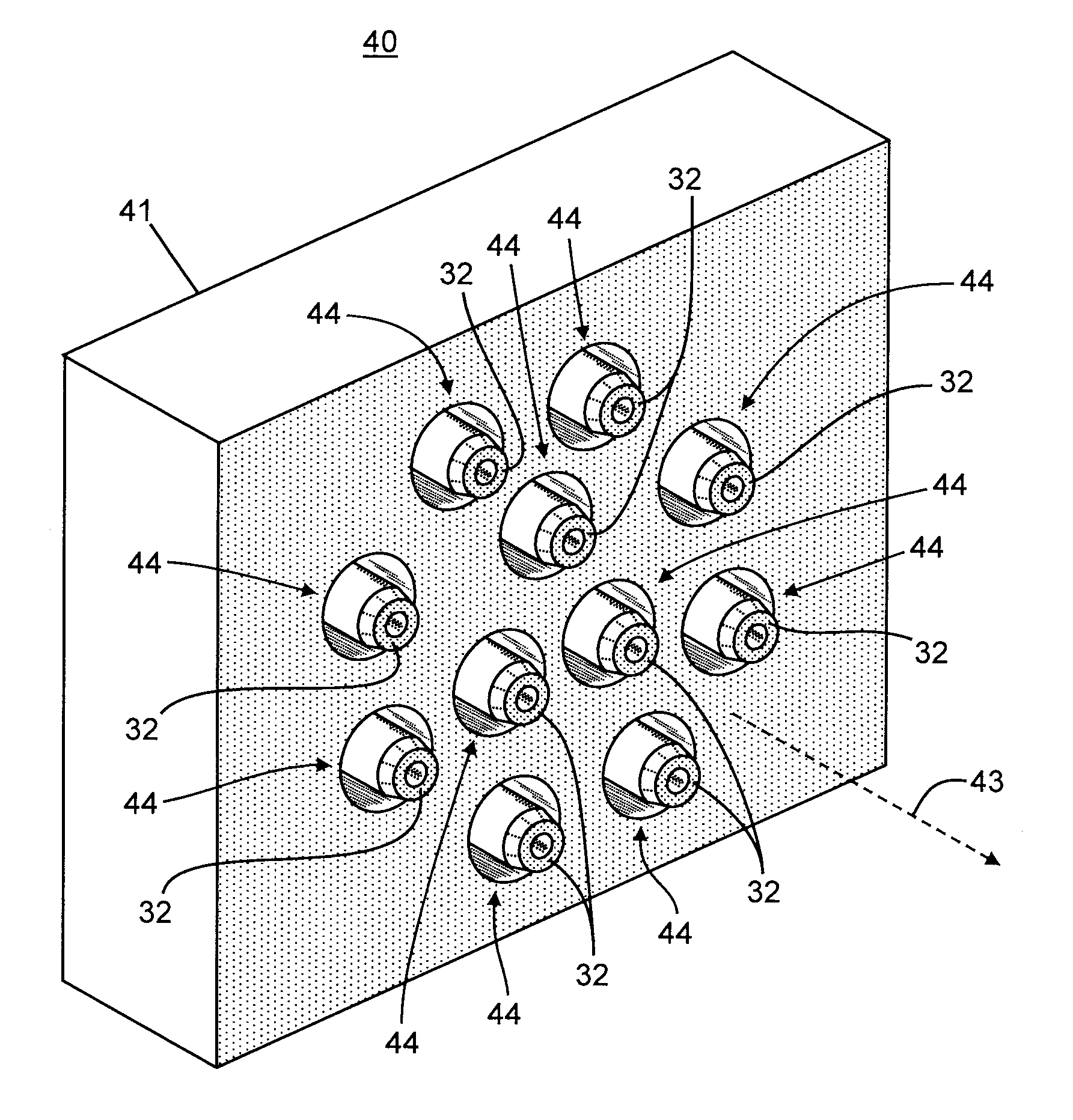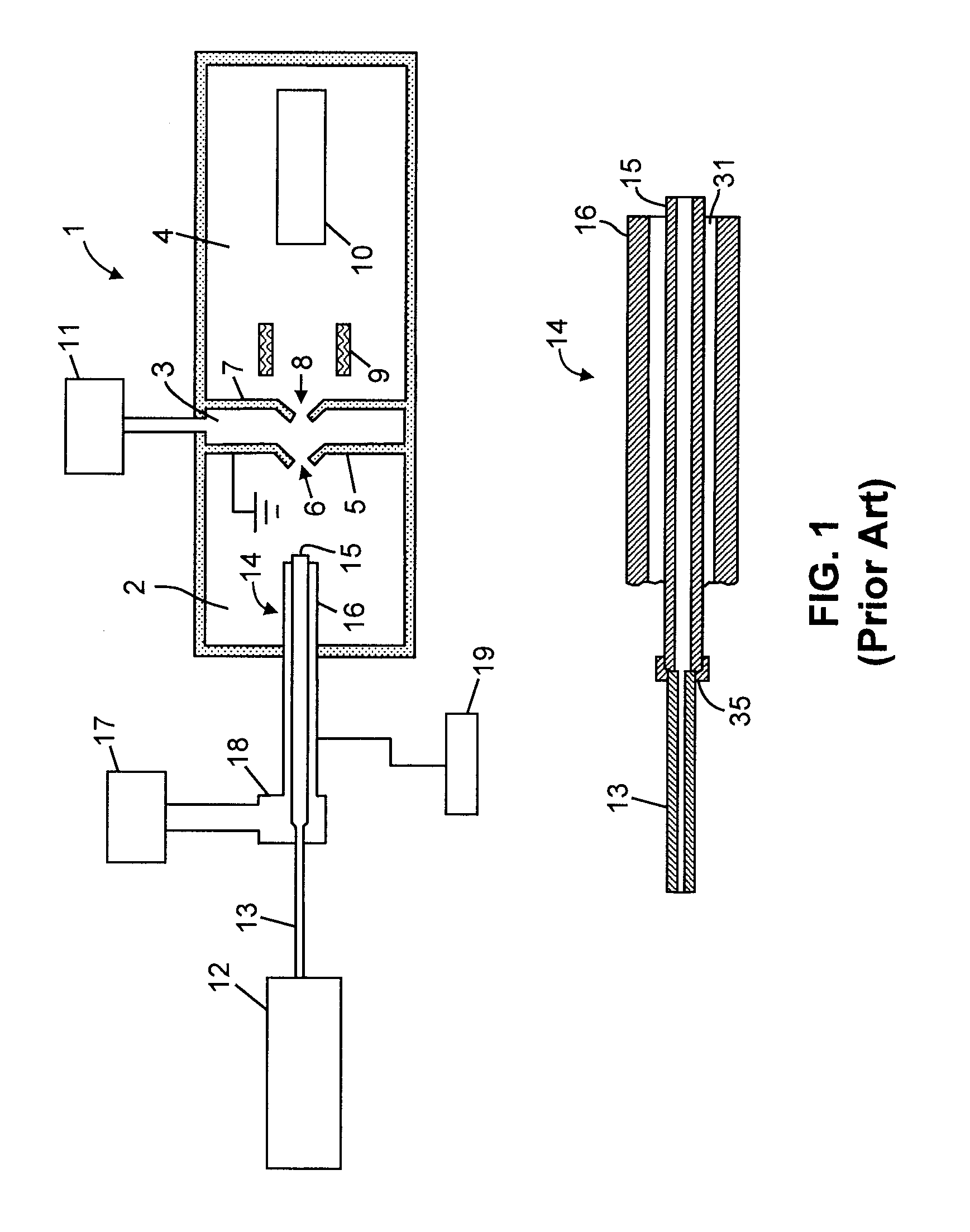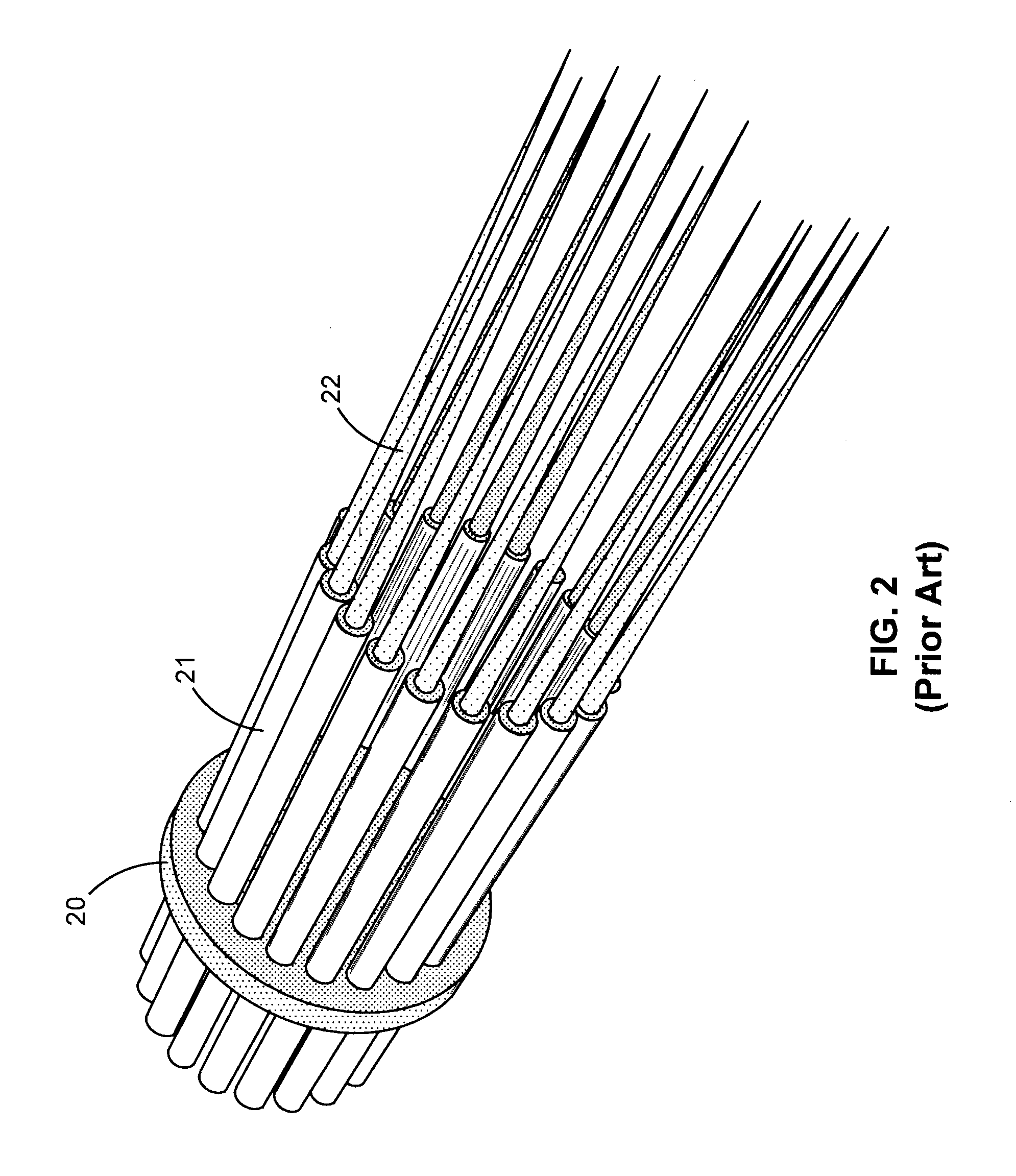[0022]We herein disclose novel electrospray ion sources and methods that take all of the above issues into consideration. The conventional single electrospray emitter within a single concentric sheath gas flow tube is replaced with a plurality of electrospray assemblies, each of which carries a fraction of the total flow of analyte-bearing liquid and that receives pneumatic assistance from circumferentially surrounding sheath gas flow. As non limiting examples, the number of these electrospray emitters can be as low as 2 or 3, and can easily be envisioned to be 15 or even higher.
[0023]In a first aspect of the invention, there is disclosed an electrospray ion source for a mass spectrometer comprising: a source of an analyte-bearing liquid; a source of a sheath gas; a plurality of liquid conduits, each liquid conduit configured so as to receive a portion of the analyte-bearing liquid from the source of analyte-bearing liquid; at least one electrode for producing electrospray emission of charged droplets from an outlet of each of said liquid conduits under application of an electrical potential to the at least one electrode; a power supply electrically coupled to the at least one electrode for maintaining the at least one electrode at the electrical potential; and a plurality of sheath gas conduits, each sheath gas conduit comprising: an inlet configured to receive a sheath gas portion from the source of sheath gas; and an outlet configured to emit a sheath gas flow that circumferentially surrounds, in at least two dimensions, a portion of the charged droplets emitted from a respective one of the liquid conduit outlets.
[0024]In a second aspect of the invention, there is disclosed an electrospray ion source for a mass spectrometer comprising: a source of an analyte-bearing liquid; a source of a sheath gas; a plurality of liquid conduits, each liquid conduit configured so as to receive a portion of the analyte-bearing liquid from the source of analyte-bearing liquid; at least one electrode for producing electrospray emission of charged droplets from an outlet of each of said liquid conduits under application of an electrical potential to the at least one electrode; a power supply electrically coupled to the at least one electrode for maintaining the at least one electrode at the electrical potential; and a sheath gas conduit comprising: an inlet configured to receive the sheath gas from the source of sheath gas; and an outlet configured to emit a sheath gas flow that circumferentially surrounds, in at least two dimensions, a portion of the charged droplets emitted from every one of the plurality of liquid conduit outlets.
[0025]In another aspect the invention, a method for providing ions to a mass spectrometer is disclosed, the method comprising: providing a source of an analyte-bearing liquid; providing a source of a sheath gas; providing a plurality of liquid conduits, each liquid conduit configured so as to receive a portion of the analyte-bearing liquid from the source of analyte-bearing liquid; providing at least one electrode associated with the plurality of liquid conduits; providing a plurality of sheath gas conduits, each sheath gas conduit comprising a sheath gas outlet configured to emit a sheath gas flow that circumferentially surrounds, in at least two dimensions, an outlet of a respective one of the liquid conduits; distributing the analyte-bearing liquid among the plurality of liquid conduits; distributing the sheath gas among the plurality of sheath gas conduits; and maintaining the at least one electrode at an electrical potential such that charged liquid droplets are emitted from the plurality of liquid conduits.
[0026]In yet another aspect of the invention, a method for providing ions to a mass spectrometer is disclosed, the method comprising: providing a source of an analyte-bearing liquid; providing a source of a sheath gas; providing a plurality of liquid conduits, each liquid conduit configured so as to receive a portion of the analyte-bearing liquid from the source of analyte-bearing liquid and having a respective outlet; providing at least one electrode associated with the plurality of liquid conduits; providing a sheath gas conduit comprising a sheath gas outlet configured to emit a sheath gas flow that circumferentially surrounds, in at least two dimensions, the outlets of the plurality of liquid conduit outlets; distributing the analyte-bearing liquid among the plurality of liquid conduits; providing the sheath gas to the sheath gas conduit; and maintaining the at least one electrode at an electrical potential such that charged liquid droplets are emitted from the plurality of liquid conduits.
[0027]In accordance with the present teachings, the diameters of each of a plurality of electrospray emitting capillaries may be smaller than is the case for a conventional single capillary. Such smaller capillaries can generate smaller initial droplets which are more readily de-solvated. Further, the smaller capillary size enables all of the electrospray emitters to be in close proximity to one another so that ions are directed to an ion inlet of a mass spectrometer. Although the emitters are in close mutual proximity, nonetheless, they are each surrounded by nebulizing sheath such that their individual Taylor cones are not perturbed and also coalescence of liquid from different sprayers does not occur. In various embodiments, each liquid capillary or conduit may be configured so as to admit a flow rate of an analyte-bearing liquid portion of between 1 microliter per minute and 1 milliliter per minute through the capillary or conduit. The total flow rate, summed over all capillaries or conduits, may range from approximately 10 microliters per minute up to approximately 10 milliliters per minute.
 Login to View More
Login to View More 


